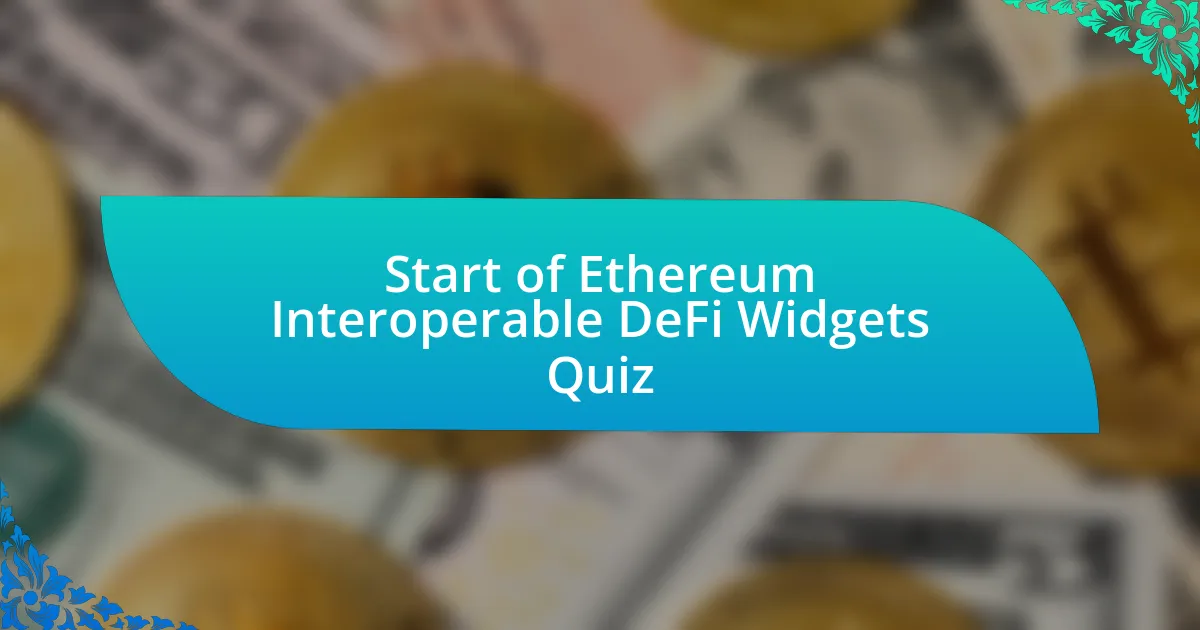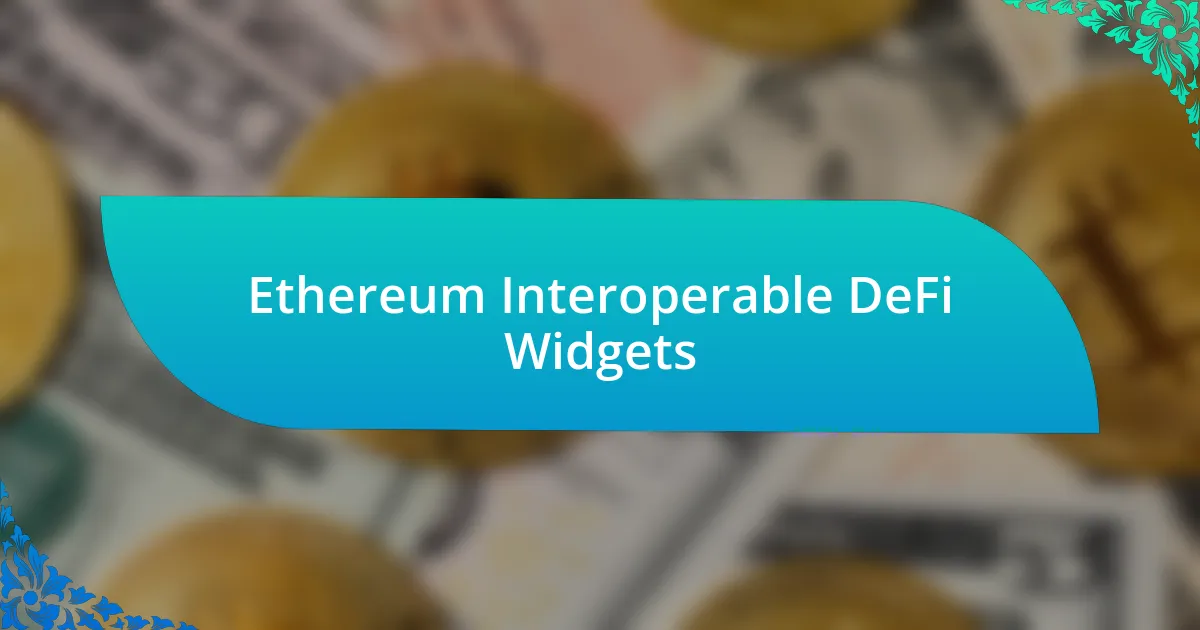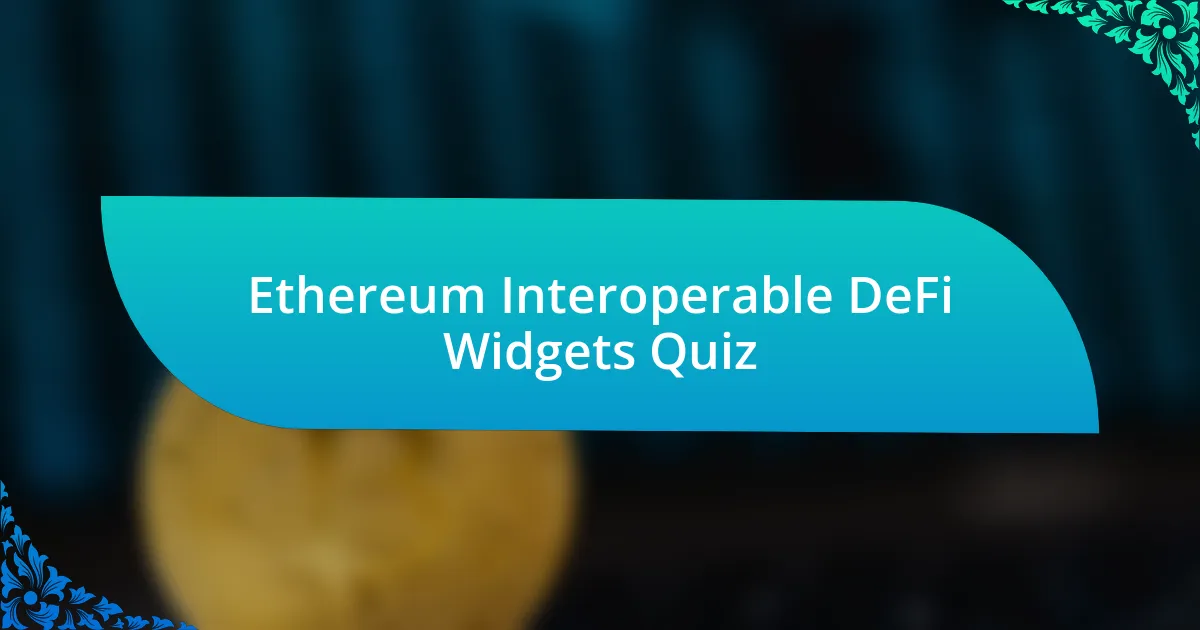
Start of Ethereum Interoperable DeFi Widgets Quiz
1. What is Ethereum Interoperable DeFi?
- Ethereum Interoperable DeFi refers to the ability of different blockchain networks and DeFi applications to seamlessly communicate and interact with each other, enhancing the efficiency and utility of the DeFi space.
- Ethereum Interoperable DeFi is a platform solely for creating new cryptocurrencies without interoperability features.
- Ethereum Interoperable DeFi allows only Ethereum-based projects to interact, limiting their functionality.
- Ethereum Interoperable DeFi refers to a single blockchain that cannot interact with others, focusing only on Ethereum.
2. Why is interoperability important in DeFi?
- Interoperability isolates each blockchain from the others.
- Interoperability increases transaction fees for all users.
- Interoperability allows the exchange of value and information across diverse platforms.
- Interoperability limits access to specific blockchain features only.
3. What are cross-chain protocols?
- Cross-chain protocols only work with centralized exchanges.
- Cross-chain protocols are exclusive to Ethereum network only.
- Cross-chain protocols allow different blockchains to communicate and share data.
- Cross-chain protocols prevent any form of blockchain interaction.
4. What are wrapped tokens?
- Wrapped tokens replace traditional fiat currencies in transactions.
- Wrapped tokens allow assets from one blockchain to interact on another blockchain.
- Wrapped tokens ensure transactions are kept within a single blockchain.
- Wrapped tokens are used to create new cryptocurrencies from scratch.
5. What are blockchain bridges?
- Blockchain bridges are algorithms used for mining new cryptocurrencies.
- Blockchain bridges are software applications that create decentralized exchanges.
- Blockchain bridges are mechanisms that connect two different blockchains, allowing assets and data to be transferred between them.
- Blockchain bridges are digital wallets for storing cryptocurrencies securely.
6. How does token transfer work with interoperability?
- Token transfer with interoperability only allows tokens to be transferred within one network.
- Token transfer with interoperability requires manual reconciliation of assets.
- Token transfer with interoperability restricts transactions to a single blockchain.
- Token transfer with interoperability enables the seamless transfer of tokens between different blockchains.
7. What is smart contract interaction in interoperability?
- Smart contract interaction in interoperability prevents any communication between blockchains.
- Smart contract interaction in interoperability only focuses on Ethereum`s internal operations.
- Smart contract interaction in interoperability allows smart contracts on one blockchain to trigger events on another blockchain.
- Smart contract interaction in interoperability connects users to wallets for transactions.
8. How does data sharing work in interoperability?
- Data sharing in interoperability facilitates the sharing of data across different blockchains, enhancing the functionality of DeFi services and applications.
- Data sharing in interoperability prevents any data exchange, ensuring complete separation of blockchains.
- Data sharing in interoperability requires manual intervention for every transaction, making it inefficient.
- Data sharing in interoperability limits information transfer to a single blockchain, reducing interaction capabilities.
9. What role do APIs play in DeFi interoperability?
- APIs facilitate interaction between DeFi applications and blockchains.
- APIs serve as a decentralized exchange for asset trading.
- APIs create new cryptocurrencies for DeFi projects.
- APIs store blockchain data in a centralized database.
10. What is the impact of interoperability on DeFi user experience?
- Interoperability has no impact on user experience in DeFi services.
- Interoperability simplifies the user experience by reducing the need for multiple wallets or accounts across different DeFi platforms.
- Interoperability complicates the user experience by requiring more accounts for each DeFi platform.
- Interoperability restricts users to single blockchain platforms for DeFi activities.
11. What are the technical aspects of interoperability in DeFi?
- Market volatility, user anonymity, regulatory compliance, and traditional bank integration
- High transaction fees, limited liquidity, user interface complications, and slow response times
- Cross-chain protocols, wrapped tokens, blockchain bridges, oracle networks, and APIs
- Centralized exchanges, multi-signature wallets, private keys, and blockchain mining
12. What is the role of cross-chain protocols in achieving interoperability?
- Cross-chain protocols prevent blockchains from interacting.
- Cross-chain protocols enable communication between blockchains.
- Cross-chain protocols only work within a single blockchain.
- Cross-chain protocols isolate blockchain networks completely.
13. What is the role of oracle networks in DeFi interoperability?
- Oracle networks provide a secure connection for DeFi protocols to access off-chain data.
- Oracle networks create decentralized exchanges for trading assets.
- Oracle networks serve as wallets for storing cryptocurrencies.
- Oracle networks enable smart contracts to run on multiple blockchains simultaneously.
14. How do APIs contribute to the security of DeFi applications?
- APIs are only used for transferring assets with no impact on security.
- APIs contribute to the security of DeFi applications by providing secure connections between different platforms, ensuring that interactions are secure and trustworthy.
- APIs prevent all hacks and fraud in DeFi applications with absolute certainty.
- APIs eliminate the need for any form of encryption in DeFi applications.
15. What is the significance of cross-chain bridges in DeFi?
- Cross-chain bridges are tools for mining cryptocurrencies exclusively on one blockchain network.
- Cross-chain bridges are hardware devices used for storing cryptocurrencies offline.
- Cross-chain bridges are legal frameworks for regulating cryptocurrency exchanges globally.
- Cross-chain bridges are essential infrastructure components that facilitate the interoperability of different blockchain networks, enabling the seamless transfer of digital assets and data between separate blockchain ecosystems.
16. What are atomic swaps in the context of DeFi?
- Atomic swaps are systems that verify transactions after both parties receive tokens.
- Atomic swaps are transactions that require a trusted third party to complete exchanges.
- Atomic swaps are contracts that lock funds for a predetermined time before exchange.
- Atomic swaps are peer-to-peer exchanges that facilitate direct cryptocurrency trades without intermediaries.
17. What is the primary benefit of cross-chain bridges in DeFi?
- Enhanced mining rewards
- Reduced transaction costs
- Greater centralization of assets
- Increased liquidity and accessibility
18. How do wrapped tokens enable interoperability?
- Wrapped tokens allow for the creation of new cryptocurrencies on a single blockchain.
- Wrapped tokens increase the transaction speed on the original blockchain.
- Wrapped tokens enable the use of one blockchain’s token on another blockchain.
- Wrapped tokens enable smart contracts to execute independently of any blockchain.
19. What is the importance of high interoperability in DeFi?
- High interoperability allows users to access and exercise DeFi protocols seamlessly across different blockchain networks.
- High interoperability limits users to a single blockchain network, reducing accessibility.
- High interoperability complicates interactions within DeFi, creating barriers for users.
- High interoperability reduces the number of DeFi applications available to users.
20. How does interoperability impact the scalability of DeFi operations?
- Interoperability enhances the scalability of DeFi operations by allowing users to access a wider range of DeFi services, regardless of the blockchain they operate on, thereby increasing liquidity and enabling more sophisticated liquidity tools.
- Interoperability limits the scalability of DeFi operations by increasing dependencies on single blockchains.
- Interoperability has no effect on the scalability of DeFi operations and operates independently.
- Interoperability complicates the scalability of DeFi operations by requiring multiple transactions across networks.
21. What are the components of a blockchain network?
- Smart contracts, tokens, and miners
- DApps, forks, and virtual machines
- Hashing, API, and oracles
- Nodes, ledger, and wallets
22. What is the role of the nonce in a blockchain transaction?
- The nonce is a type of cryptocurrency used for digital contracts.
- The nonce is used to verify the identity of a blockchain user.
- The nonce is a number added to a hashed block to prevent replay attacks.
- The nonce serves as a transaction fee in a blockchain network.
23. What is hashing in the context of blockchain?
- Hashing encrypts data to protect privacy during transactions.
- Hashing stores data in a decentralized network for easy access.
- Hashing creates physical copies of data for better retrieval.
- Hashing maps data to a fixed size, playing a crucial role in cryptography.
24. What are the types of forks in a blockchain?
- Soft forks, hard forks, and temporary forks
- Clean forks, dirty forks, and fuzzy forks
- Failed forks, silent forks, and loud forks
- Hidden forks, lost forks, and trace forks
25. Which technology is used in Bitcoin?
- Cloud computing
- Blockchain technology
- Artificial intelligence
- Internet connectivity
26. What is the term used for a blockchain split?
- Split
- Branch
- Divergence
- Fork
27. What are the pillars of blockchain technology?
- Speed, linearity, complexity
- Immutability, decentralization, transparency
- Centralization, accessibility, cost
- Flexibility, privacy, anonymity
28. Where do you keep your cryptocurrency?
- USB drive
- Bank account
- E-wallet
- Social media account
29. What is a blockchain?
- A blockchain is a software application used for online banking.
- A blockchain is a form of social media platform for sharing information.
- A blockchain is a database that saves encrypted chunks of data and connects them to build a chronological single source of truth for the data.
- A blockchain is a type of cryptocurrency that functions as a virtual currency.
30. What are the building blocks of DeFi infrastructure?
- Blockchain, smart contracts, oracles, stablecoins, and dApps
- Hashing algorithms, mining rigs, network cables, and firewalls
- Centralized exchanges, fiat currencies, banks, and credit cards
- Password managers, email accounts, web browsers, and servers

Quiz Successfully Completed!
Congratulations on finishing the quiz on Ethereum Interoperable DeFi Widgets! You’ve navigated through crucial concepts that shape the future of decentralized finance. It’s great to reflect on all the insights gained. You might now understand how different DeFi widgets work together to enhance user experience and productivity in the Ethereum ecosystem. This knowledge is essential in a rapidly evolving landscape.
Throughout the quiz, you explored the importance of interoperability in DeFi. You learned how various platforms and tools can communicate with one another. This interconnectedness not only improves efficiency but also opens doors to new financial opportunities. Such insights are vital for anyone looking to deepen their understanding of blockchain technology and its applications.
If you want to dive deeper into the topic, we invite you to check the next section on this page. It offers comprehensive information about Ethereum Interoperable DeFi Widgets. Enhancing your knowledge in this area can empower you to make informed decisions in your DeFi activities. Keep exploring and expanding your horizons!

Ethereum Interoperable DeFi Widgets
Understanding Ethereum and Its Role in Decentralized Finance
Ethereum is a decentralized blockchain platform that enables developers to build and deploy smart contracts and decentralized applications (dApps). Its programmable nature allows for the creation of a wide array of financial products and services without intermediaries. This innovation has given rise to decentralized finance (DeFi), a movement aiming to recreate traditional financial systems in a decentralized manner. Ethereum’s robust infrastructure facilitates interoperability between these applications, enhancing access to services and liquidity across platforms.
What Are Interoperable DeFi Widgets?
Interoperable DeFi widgets are modular components that can be integrated into various DeFi applications on the Ethereum network. These widgets provide standardized functionalities, such as token swaps, lending services, or liquidity pools. By being interoperable, they enable seamless interaction across different platforms, allowing users to engage with multiple DeFi services without encountering compatibility barriers. This reduces friction in the user experience and encourages greater participation in the DeFi ecosystem.
The Significance of Interoperability in DeFi
Interoperability in DeFi enhances user experience and efficiency by allowing users to access diverse financial services within a single interface. It promotes liquidity by enabling assets to move freely among different platforms and applications. This interconnectedness also fosters innovation, as developers can build on existing solutions rather than starting from scratch. The Ethereum network’s standards, such as ERC-20 and ERC-721, aid in ensuring that these widgets can communicate and function across different applications effectively.
Examples of Ethereum Interoperable DeFi Widgets
Examples of Ethereum interoperable DeFi widgets include Uniswap’s liquidity pools, Aave’s lending and borrowing functionality, and Chainlink’s oracles. These widgets allow users to perform complex financial transactions with ease. For instance, Uniswap enables users to swap tokens directly from their wallets, while Aave facilitates peer-to-peer lending and borrowing. Each of these widgets operates within the Ethereum ecosystem, demonstrating the power of interoperability through seamless transactions and interactions among various DeFi applications.
The Future of Interoperable DeFi Widgets on Ethereum
The future of interoperable DeFi widgets on Ethereum looks promising, driven by ongoing technological advancements and community development. As Ethereum evolves with updates like Ethereum 2.0, scalability and transaction speeds will improve, further enhancing the usability of these widgets. Continuous innovation in cross-chain solutions may also extend interoperability beyond Ethereum, allowing widgets to interact with other blockchain networks. This expansion is likely to create a more inclusive and robust DeFi landscape.
What are Ethereum Interoperable DeFi Widgets?
Ethereum Interoperable DeFi Widgets are modular components designed for decentralized finance (DeFi) applications on the Ethereum blockchain that enable seamless interaction between different protocols. These widgets allow various DeFi services, such as lending, trading, and liquidity provision, to function cohesively across multiple platforms. Their interoperability is crucial in enhancing user experience and expanding the functionality of DeFi systems, creating a more interconnected financial ecosystem.
How do Ethereum Interoperable DeFi Widgets work?
Ethereum Interoperable DeFi Widgets operate through smart contracts that facilitate communication between different DeFi protocols. They use standardized interfaces, such as ERC-20 tokens and ERC-721 for non-fungible tokens, to ensure compatibility across various platforms. By leveraging these technologies, widgets can execute transactions, share data, and access resources from other services, allowing users to interact with multiple DeFi applications without complex integrations.
Where can I find Ethereum Interoperable DeFi Widgets?
Ethereum Interoperable DeFi Widgets can be found on various decentralized finance platforms and marketplaces. Popular platforms like Uniswap, Aave, and SushiSwap often incorporate these widgets within their user interfaces. Developers can also access them through open-source repositories on platforms like GitHub, where many projects share their widget configurations for community use and enhancement.
When were Ethereum Interoperable DeFi Widgets first introduced?
Ethereum Interoperable DeFi Widgets began to emerge around 2018, coinciding with the rise of DeFi applications on the Ethereum blockchain. The introduction of protocols like MakerDAO and Compound showcased the need for interoperability among various financial services. As the DeFi ecosystem matured, the development and deployment of interoperable widgets became more widespread, enhancing user engagement and participation in decentralized finance.
Who benefits from Ethereum Interoperable DeFi Widgets?
Both developers and users benefit from Ethereum Interoperable DeFi Widgets. Developers can create applications that utilize these widgets to enhance functionality and improve user experience without building from scratch. Users benefit from simplified access to diverse financial services, allowing them to manage assets, trade, and swap tokens across multiple protocols seamlessly, leading to increased efficiency and lower transaction costs.

